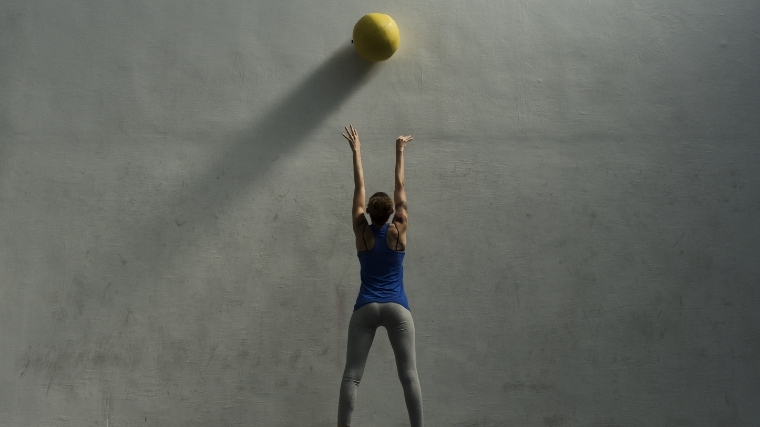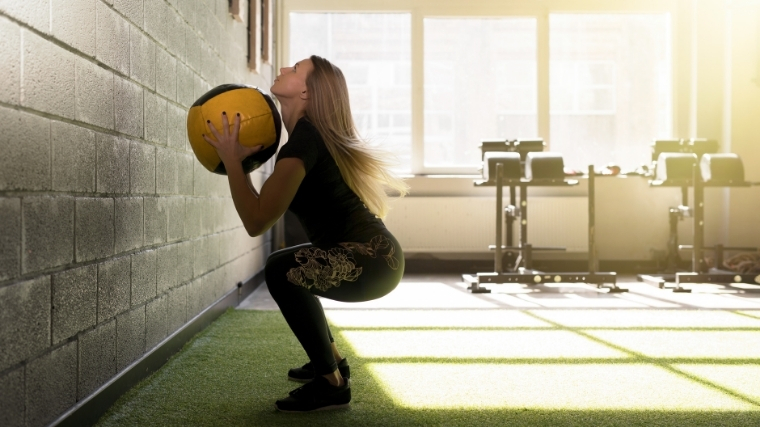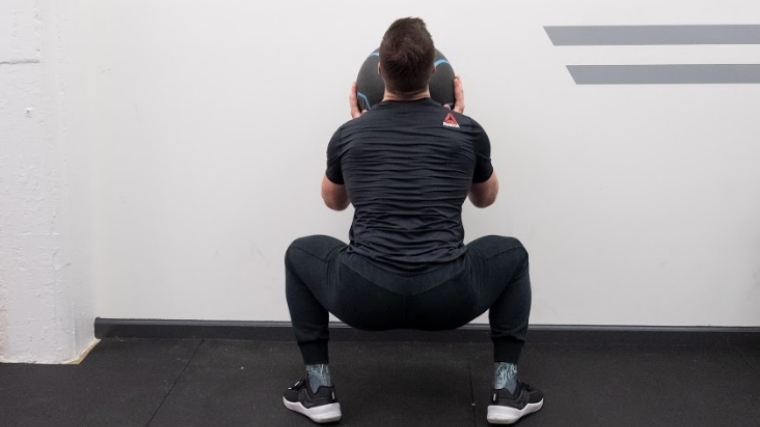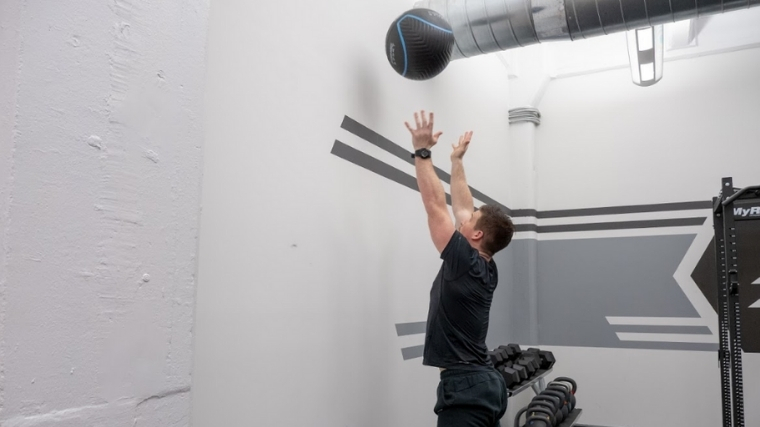Most of us know all too well the feeling of the burning lungs, weak, flaccid arms, and legs that are on the verge of buckling. We’re talking about wall balls — the dynamic squat and press exercise that CrossFitters made famous for their conditioning and fat-burning benefits. If you haven’t had the pleasure of trying wall balls, you’re in for a nightmarish treat. We say nightmare because these will test your cardio beyond what you’re probably used to. And we say treat as you’ll accumulate some serious shoulder and leg endurance. (Not to mention crushing rep after rep of wall balls look pretty badass.)
Below, you’ll find everything you need to know about wall balls: How to do them, their benefits, how to program with them, and alternatives to try.
- How to Do the Wall Ball
- Benefits of the Wall Ball
- Muscles Worked By the Wall Ball
- Who Should Do the Wall Ball
- Wall Ball Sets, Reps, and Programming Recommendations
- Wall Ball Alternatives
- Frequently Asked Questions
Wall Ball Video Guide
In the video below, former BarBend editor Jake Boly and CrossFit coach Andre Crews walk you through each step of doing perfect wall ball reps.
[Related: Burn Fat and Boost Your Work Capacity With Body Conditioning]
How to Do the Wall Ball
The wall ball is an endurance and work capacity-building movement done for either high reps or time.
Step 1 — Set Up
Set your feet shoulder-width apart, with the toes roughly eight to 12 inches away from the all (face the wall). Then, grab a medicine ball or slam ball and hold the weight directly under your chin with your elbows tucked in. Brace your core, tense your back, and ensure that you feel stable. Think about pulling your ribs down into the body and making sure your abs are engaged.
Form Tip: Don’t slouch in this position. Squeeze your shoulder blades back to maintain an upright posture.
Step 2 — Squat Down
Before initiating the squat, grip the floor with your feet. Keep your feet firmly planted, and then twist them outward until you feel your quads, hamstrings, and glutes light up. Then, drop down, keeping your torso upright until the bottom of your thighs are parallel to the floor. If you can, aim to squat deeper.
Form Tip: Think about pushing the back of your hamstrings to the back of your calves. The deeper the squat, the better (most of the time).
Step 3 — Stand Up and Throw the Ball
Stand up, keeping your hips underneath you, and don’t let your chest and torso fall forward. As you reach full extension, accelerate and continue and push the ball overhead, throwing it at a target above you on the wall. Catch the ball on the way down and go directly into your next repetition.
Form Tip: Keep your hips under you as you stand up, and contract the glutes forcefully as you stand up. Be aggressive as you stand up to generate more upward momentum.
Benefits of Wall Balls
Below are a few benefits of performing wall balls, as either a movement as a whole or within a metabolic circuit.
More Endurance
The wall ball is a two-in-one exercise that builds serious shoulder and quad endurance (from the throws and squats) and cardiovascular endurance. The continuous squatting and tossing is a full-body movement that creates a serious burn in your lungs and muscles. What’s more, this movement is typically done for many reps or time, which is another reason why your entire system will be under siege. The good news is that you’ll develop a tolerance for high-reps and cardio work that isn’t earned on a treadmill or exercise bike.
Better Squat Form
The first half of the wall ball is essentially a goblet squat, a beginner-friendly movement that reinforces proper squatting mechanics. The great thing about wall balls is that you can program a gazillion of them into a training session promptly to add quality reps and motor movement to beginners and/or reinforce proper squat patterning to pros.
Midline Stability
Midline stability refers to your ability to remain straight during all movement. Core strength is a major factor, but so is overall proprioception, balance, and awareness. The wall ball has you move through multiple planes of movement while adding extreme stress to your muscles and cardiovascular system. If you can make it through sets of wall balls, then you’ll be more stable overall, and that stability will carry over to any exercise you take on.
Muscles Worked by Wall Ball
It’s probably easier to list the muscles that the wall ball doesn’t affect. Still, we’ll list the major muscles worked by wall balls below.

Quadriceps
Your quads extend the knees, which is what happens during a squat. Considering half of the wall ball movement is a squat, you can bet your quads will be feeling it by the end of set one.
Shoulders and Upper Chest
The shoulders and upper chest muscles are used to throw the ball overhead after reaching extension in the squat. By keeping the elbows tucked into the body more, you can conserve shoulder stamina and increase the demands on the triceps and chest.
Gluteals
The glute muscles extend the hips as you stand up. When doing wall balls, it is helpful to open the hips at the top and flex the glutes to maximize leg and hip drive.
Triceps
The triceps work to extend the elbows needed to fully throw the wall ball overhead high enough to hit the target. The triceps are a secondary muscle group used, which means that while they are not the main mover in the exercise (such as the quads and shoulders), they still play an important role.
Who Should Do the Wall Ball?
Below are some reasons why strength, power, and fitness athletes may benefit from performing the wall ball.
Strength and Power Athletes
This isn’t really an exercise for strength athletes. The weight of the medicine ball isn’t nearly enough to prep the body for heavy sets of squats, deadlifts, and presses. And while work capacity is an important factor for any and all strength athletes, there are more practical ways to increase conditioning — such as the rower, loaded carries, and higher-rep sets with heavy weights.
That said, it is a great way to warm up before a lifting session. You’ll fine-tune your squat mechanics and warm up your muscles in the process. Just don’t overdo it. Stick with two sets of 15 reps or so with a light medicine ball.
Fitness Athletes
For CrossFitters and other functional fitness athletes, the wall ball is a common competition movement. As is the norm in those sports, reps are often really, really high. So, program accordingly and do these often.
General Population
If you’re a general gym-goer, we suggest programming the wall ball as a part of your warm-up for the same reasons listed under “strength athletes” or for conditioning after a workout.
Wall Ball Sets, Reps, and Programming Recommendations
Because of the lightweight, high-rep nature of the wall ball, you can really only use it for two things — better squat form and muscular endurance. Want more leg and shoulder muscle? Stick with leg exercises and proven shoulder exercises. For strength gains, you’re better off lifting heavy weights for proven set and rep ranges. The wall ball is a particular and specialized exercise.

To Improve Squat Mechanics
Wall balls can be a great way to help reinforce proper squat mechanics, improve the stretch reflex system for the squat, and help increase work capacity for the lower body. You can start your session off with these as a part of a warm-up. Do two sets of 15 reps, resting 30 seconds between sets.
To Improve Muscle Endurance
This is a full-body, full range of motion movement, which means it can have a high metabolic cost to anyone who performs them. Do either four sets of 25 reps or set a timer for five minutes and aim to accumulate as many reps as possible. Rest 30 seconds between sets and then rest as needed for the five-minute challenge.
Wall Ball Alternatives
Below are three wall ball alternatives coaches and athletes can use to increase squat mechanics and muscle hypertrophy/endurance.
Dumbbell Thruster
The thruster is a full body squat to press exercise that, like the wall ball, increases muscular endurance and improves squat mechanics. Unlike the wall ball, however, the thruster can also be programmed to build strength and be a useful exercise for strength and power athletes looking to increase leg drive and leg strength and power. Adding external loading — with dumbbells, kettlebells, or barbells — makes this a great wall ball alternative for those looking to use the squat to press movement to build serious strength and power.
[Related: The Best Dumbbells for Durability, Adjustability, Premium Options, and More]
Landmine Squat to Press
The barbell landmine squat to press is similar to the wall ball and thruster in that it can increase squat mechanics, endurance, and strength. The landmine attachment allows you to hit the movement from a slightly different angle and can be used for individuals who may have issues going overhead with a barbell due to shoulder injury or mobility issues. The 45-degree(ish) angle of the landmine press is, typically, more comfortable on the shoulder joint.
[Related: Elevate Your Presses and Squats With the 6 Best Landmine Exercises]
Jump Squat
The jump squat is a foundational plyometric exercise that anyone can do without added weight (you can use a weight vest or dumbbell if you want). This is a great alternative to the wall ball as it helps build athleticism, power and improve squat mechanics.
[Related: Here’s How to Do the Dumbbell Jump Squat]
FAQs
Are wall balls a beginner-friendly exercise?
Wall balls can be a beginner-friendly exercise if you understand how to squat properly. If you do, use lighter loads to increase work capacity and hone squat mechanics. Otherwise, focus on mastering bodyweight squats and then goblet squats first before graduating to this variation.
Can wall balls help me squat more weight?
No. Not really. That said, you can use them at times to reinforce proper squat mechanics needed to squat heavier with a barbell, improve positioning for the front squat, and help increase lower-body work capacity. All those factors will play into bigger squats.
How heavy can I train wall balls?
You can go as heavy as possible while still maintaining proper form. However, we suggest performing no less than eight reps, and with good speed. Remember, this movement is about high reps and endurance. So stick with less weight.
Featured image: Luka Funduk/Shutterstock


